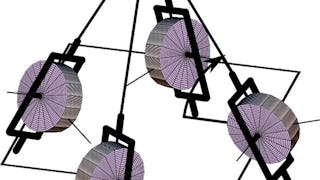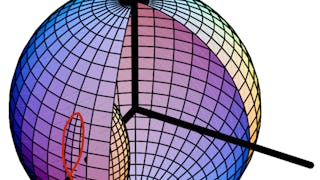This course is part 2 of the specialization Advanced Spacecraft Dynamics and Control. It assumes you have a strong foundation in spacecraft dynamics and control, including particle dynamics, rotating frame, rigid body kinematics and kinetics. The focus of the course is to understand key analytical mechanics methodologies to develop equations of motion in an algebraically efficient manner. The course starts by first developing D’Alembert’s principle and how the associated virtual work and virtual displacement concepts allows us to ignore non-working force terms. Unconstrained systems and holonomic constrains are investigated. Next Kane's equations and the virtual power form of D'Alembert's equations are briefly reviewed for particles.


Analytical Mechanics for Spacecraft Dynamics
This course is part of Advanced Spacecraft Dynamics and Control Specialization

Instructor: Hanspeter Schaub
Included with
(11 reviews)
Recommended experience
What you'll learn
Use virtual work methods to develop equations of motion of mechanical systems.
Understand how to use Lagrange multipliers to study constrained dynamical systems.
Be able to derive the equations of motion of a spacecraft with flexible sub-components.
Skills you'll gain
Details to know

Add to your LinkedIn profile
23 assignments
See how employees at top companies are mastering in-demand skills

Build your subject-matter expertise
- Learn new concepts from industry experts
- Gain a foundational understanding of a subject or tool
- Develop job-relevant skills with hands-on projects
- Earn a shareable career certificate

There are 3 modules in this course
Learn the methodology of developing equations of motion using D'Alembert's principle, virtual power forms, Lagrange's equations as well as the Boltzmann-Hamel equations. These methods allow for more efficient equations of motion development where state based (holonomic) and rate based (Pfaffian constraints) are considered.
What's included
24 videos10 assignments
Derive methods to develop the equations of motion of a dynamical system with finite degrees of freedom based on energy expressions.
What's included
19 videos6 assignments
Learn to develop the equations of motion for a dynamical system with deformable shapes. Such systems have infinite degrees of freedom and lead to partial differential equations.
What's included
21 videos7 assignments
Earn a career certificate
Add this credential to your LinkedIn profile, resume, or CV. Share it on social media and in your performance review.
Instructor

Offered by
Explore more from Physics and Astronomy
 Status: Free Trial
Status: Free TrialUniversity of Colorado Boulder
 Status: Free Trial
Status: Free TrialUniversity of Colorado Boulder
 Status: Free Trial
Status: Free TrialUniversity of Colorado Boulder
 Status: Free Trial
Status: Free TrialUniversity of Colorado Boulder
Why people choose Coursera for their career




Learner reviews
11 reviews
- 5 stars
81.81%
- 4 stars
18.18%
- 3 stars
0%
- 2 stars
0%
- 1 star
0%
Showing 3 of 11
Reviewed on Oct 1, 2023
Learnt so much (almost) without effort. Prof. Shaub's teaching is outstanding.

Open new doors with Coursera Plus
Unlimited access to 10,000+ world-class courses, hands-on projects, and job-ready certificate programs - all included in your subscription
Advance your career with an online degree
Earn a degree from world-class universities - 100% online
Join over 3,400 global companies that choose Coursera for Business
Upskill your employees to excel in the digital economy
Frequently asked questions
This course does stand on its on. It is still recommended that you have a strong foundation in particle dynamics, rotating frames, rigid body kinematics, etc.
To access the course materials, assignments and to earn a Certificate, you will need to purchase the Certificate experience when you enroll in a course. You can try a Free Trial instead, or apply for Financial Aid. The course may offer 'Full Course, No Certificate' instead. This option lets you see all course materials, submit required assessments, and get a final grade. This also means that you will not be able to purchase a Certificate experience.
When you enroll in the course, you get access to all of the courses in the Specialization, and you earn a certificate when you complete the work. Your electronic Certificate will be added to your Accomplishments page - from there, you can print your Certificate or add it to your LinkedIn profile.
More questions
Financial aid available,

